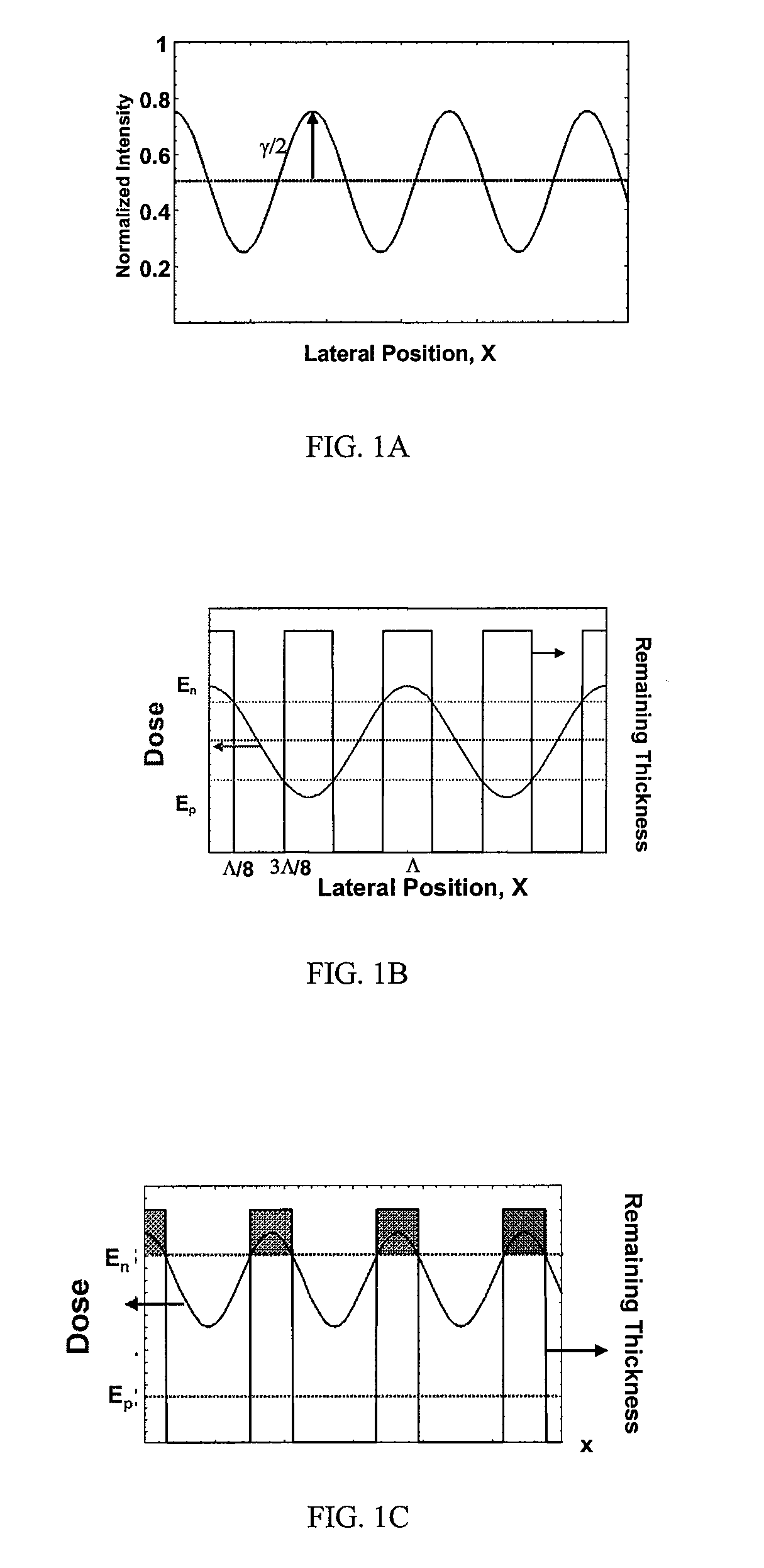Multi-tone resist compositions
- Summary
- Abstract
- Description
- Claims
- Application Information
AI Technical Summary
Benefits of technology
Problems solved by technology
Method used
Image
Examples
example 1
Preparation of Resists
[0086]Resists were prepared by combining the materials listed in Table 1, rolling the solution overnight and filtering to 0.2 micrometers. All resists contained 2250 parts by weight of cyclohexanone as the resist solvent. The polymer employed is poly(ethyladamantyl methacrylate-co-γ-butyrolactone methacrylate-co-hydroxyladamantyl methacrylate) in a 23:58:19 monomer ratio (Poly-A2). The PAG is either di-(t-butylphenyl)iodonium nonafluoro-1-butanesulfonate (TBPI-PFBS) or triphenylsulfonium nonafluoro-1-butanesulfonate (TPS-PFBS) and the base is tetrabutylammonium hydroxide.
TABLE 1Components of resist formulation as parts by weight.PAGBaseResistPolymerPolymer (parts)PAG (type)(parts)(parts)25011Poly-A2240TBPI-PFBS10125012Poly-A2230TBPI-PFBS20125013Poly-A2240TPS-PFBS10125014Poly-A2230TPS-PFBS201
[0087]The resist compositions were coated onto fused silica substrates at designated thicknesses for testing.
example 2
Resist Performance with a 0.26 N Developer
[0088]Resists 25011, 25012, 25013, and 25014 were coated to about 300 nm, PAB baked at 140° C. for 60 s, exposed at 193-nm, PEB baked at either 130 or 150° C. for 60 s, and developed for 40 s with LLD-26W (2.38% tetramethyl ammonium hydroxide, Shipley Co., Marlborough, Mass.). Results are given in Table 2.
TABLE 2Lithographic performance of dual tone resists.PEB temp.E0En50Resist(C.)(mJ / cm2)Positive γ(mJ / cm2)Negative γ2501113026.77.9>400NA2501115026.17.4>400NA250121304.38.1>400NA250121504.26.913.919.0250131308.09.0>400NA250131508.25.6>400NA250141304.55.7>400NA250141504.54.914.733.9
[0089]The results show that a dual tone resist can be prepared and that the resist shows negative behavior with high levels of PAG and higher PEB temperatures. The resist sensitivity for both positive and negative behavior is sufficiently high to allow high throughput manufacturing of integrated circuits. The results also show that the resist has sufficient contrast...
example 3
Resist Performance with a 0.13 N Developer
[0090]Resists 25011, 25012, 25013, and 25014 were coated to about 300 nm, PAB baked at 140° C. for 60 s, exposed at 193-nm, PEB baked at either 130 or 150° C. for 60 s, and developed for 40 s with a 1:1 mixture of DI water:LLD-26W. Results are given in Table 3.
TABLE 3Lithographic performance of dual tone resists.PEB temp.E0En50Resist(C.)(mJ / cm2)Positive γ(mJ / cm2)Negative γ2501113022.318.4>400NA2501115020.428.3>400NA250121305.08.7>400NA250121505.75.113.717.1250131307.96.9>400NA250131508.78.919.253.4250141304.75.1>400NA250141505.24.89.26.3
[0091]The results show that a dual tone resist can be prepared and that the resist shows negative behavior with higher PEB temperatures. The resist sensitivity for both positive and negative behavior is sufficiently high to allow high throughput manufacturing of integrated circuits. The results also show that the resist has sufficient contrast in both the positive and negative tone to expect high resolution i...
PUM
| Property | Measurement | Unit |
|---|---|---|
| Length | aaaaa | aaaaa |
| Nanoscale particle size | aaaaa | aaaaa |
| Nanoscale particle size | aaaaa | aaaaa |
Abstract
Description
Claims
Application Information
 Login to View More
Login to View More - R&D
- Intellectual Property
- Life Sciences
- Materials
- Tech Scout
- Unparalleled Data Quality
- Higher Quality Content
- 60% Fewer Hallucinations
Browse by: Latest US Patents, China's latest patents, Technical Efficacy Thesaurus, Application Domain, Technology Topic, Popular Technical Reports.
© 2025 PatSnap. All rights reserved.Legal|Privacy policy|Modern Slavery Act Transparency Statement|Sitemap|About US| Contact US: help@patsnap.com



